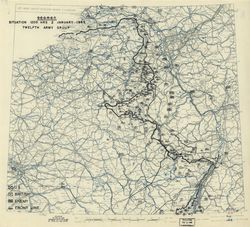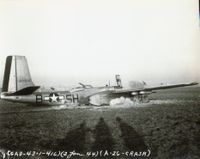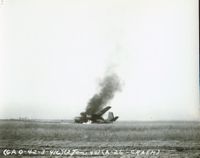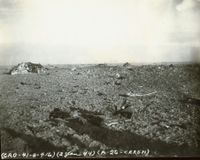 |
Lou Prucha WWII Service
|
 |
Simmern, Germany
(Railroad Bridge)

Pilot's Flight Log |

12th Army Group Situation Map 02-Jan-1945 |
His aircraft was 668 Bomb Sq. Fuselage code 5H-I Model A-26B-20-DL Invader, Serial # 41-39264.
Click to display the official 416th Bomb Group Mission Folder, Mission Report and Operational Report
scanned to PDF files by the Air Force Historical Research Agency (AFHRA).
The Photos above are from the Captain Francis J. Cachat's 416th Photo Collection and show three A-26 planes that crashed on take-off due to weather.
Group, Unit and Historical Extracts for Mission 181
"416th Bombardment Group (L) - Group History 1945"
Transcribed from USAF Archives
A small but important railroad bridge at Simmern, Germany, was attacked on the 2nd. It was on the direct route from the Frankfurt area to Trier. The weather was very cold with much snow and ice covering the field. On the take-off, two A-26s crashed. Both crashed after the planes had gotten into the air. The bombs from the first plane exploded immediately and the plane burned. Both the pilot, Lt H.B. Clark, and his gunner, Staff Sergeant J.W. Sabadosh, were killed. The crew of the other plane, Lt R.J. Lackner and Sgt A.J. Musserra, crawled from the wreckage to safety just before the bombs exploded and uninjured. A third plane refused to get more than a few feet off the ground and settled down at the end of the runway where the landing gear collapsed. Its crew, Lt Wm. H. Roberts, and Sergeant Raymond P. Windisch, were uninjured. The reasons for the crashes are unknown, although icing of the wings or carburetor might have caused them. Twenty-seven planes bombed the target with 45 tons of bombs, scoring excellent to superior results. The hits blanketed the bridge, railroad tracks, and the highway. Lt Col Willetts, Lt Royalty, B-N, and Captain Pair, Lt Corum, B-N, were the box leaders. It was reported that five to 12 ME 109s attempted a pass at the formation, but they were steered away by our fighter escort.
"Attack Bombers, We Need You! A History of the 416th Bomb Group"
Ralph Conte
Pages 191 - 192
Mission #181 - 2 January - Simmern Bridge 26 miles north of Coblenz. Lt. Col. Willetts and Lt. Royalty, BN led Box I - Lt. Pair and Lt. Corum led Box II. Other flights were led by Lt. Stanley and F/O Blount, BN - Lt. Evans and Lt. McCartney, BN - Lts. Lackovich and Muir, BN. The field was covered with ice and snow and a haze covered the runway. A few ships did not make it to the runway due to poor visibility, but those that did, met with disasterous results. The first A-26 piloted by Lt. H. P. Clark with gunner S/Sgt. J. W. Sabadosh took off and crashed not far from the end of the runway. The plane, loaded with 1000 pound bombs exploded, killing both men. A second plane with Lt. R. J. Lackner at the controls, with gunner Sgt. A. J. Musserre crashed about a mile from the runway end, just about where the first plane exploded.
The crew of the second plane ran from the downed plane and sought safety, just as their bombs exploded, not harming them. The explosion knocked out windows of the squadron headquarters building. Lt. Rooney of the 670th squadron, was edging his plane down the runway for takeoff but something malfunctioned and he pulled up right off the end of the runway. Another plane behind Rooney took off and made it off the end of the runway, but didn't get more than a few feet off the ground and it went down. Rooney left his plane and when a third plane hit, he started to run toward them to help, if he could. The crew came running away from the plane and Rooney and his gunner took cover just as the 1000 pounders exploded, causing damage to Rooney's plane sitting at the end of the runway. The reasons for the failure to get off rested with icing on the wings and possibly in the carburetors. Lt. Roberts with gunner Windisch were in the third plane. Windisch was able to extricate Roberts from the plane before it exploded, too. With all that confusion to watch as other planes took off, they continued to form up and head for the target, all 27 of them. Scoring was superior and excellent, but the bridge still stood, requiring a few more mission to do it in. Flak was not too significant although ME-0109s attempted a pass at the formation, but were driven away by our fighter escorts.
"Operational History 668th Bomb Squadron (416th Bomb Group (L)) WWII"
Wayne Williams, et.al.
Mission # 161 [actually, 181] was the first entry to mar our clean board for the New Year. The morning was very foggy, with a clear sky above the layer of mist. Twelve crews were provided from this squadron, of which only eight were to fly the mission. The B/N Team were Lt. Stanley & F/O Blount, and Lt. Evans & F/O McCartney. Each led the second and third flights of the second box respectively.
Trouble struck us before and during take off. On many planes, the heavy mist had frozen on the windshields, causing limited and sometimes no visibility. Ltís Harris & Montrose were forced to turn back with engine trouble. They never had the chance to get airborne. Ltís Roberts and Lackner? really had the misfortune. Lt. Roberts took off and just getting airborne, when his engines cut out. He landed at the end of the runway and rolled out into a field where his engines caught fire. His Gunner Sgt. Windish pulled him out of the ship and the two of them headed for the trees and for cover. It proved they made it just in time, as their load of 1000 lb. bombs went off scattering the plane all over the area. To us, back in the area, we thought another raid was on, and went for the foxholes. The concussion blew Lt. Robertís from behind his tree and slid him right across a frozen pond of water. Again, luckily, no one was hurt.
Lt. Lackner?, with Cpl. Mussarra (Gunner) had about the same trouble. The only difference was, their plane didnít burst into flames or blow up. They walked away from their crash landing, neither looking back. A silent thankfulness. A neighboring sister squadron, the 669th, lost a complete crew, when their ship blew up in the air. The cause for this has not been determined as yet. For the first mission of the year, you can say it was sent off in blood.
The target was the Railroad Bridge at Simmern. With all the trouble at the beginning, the crews were determined to make this mission a good one. They did beyond a doubt. The formation dropped their 1000 lb. missiles from the altitude of 11,600 feet and 12,000 feet, and they fell true to their mark. There was no flak coming and going, and all crews returned with no losses, casualties, or battle damage. Photos proved to the accuracy of the B/Nís. The team of Evans & McCartney brought laurels back to the squadron with a "superior" on their bombing. Stanley & Blount, bombing with another flight, came back with an "excellent". All in all, there were three "excellents" and two "superiors" scored by the Group. In a way, this was some consolation for the mishaps that occurred at the beginning. This mission was the only flying for the day.
Two more "65" pilots have left for the States recently. They are; Capt. A.N. Osborne Jr., and 1st Lt. R.G. Meredith. They are the last two pilots t leave of the original bunch that came over with us. To them we wish the best in their future endeavors.
The base is still on an "alert" basis, with guards posted everywhere. We have had no recent visits from Jerry, and all is rather quiet at present. Knock on wood!
"668th Bombardment Squadron (L) History"
Transcription from USAF Archives
Operation of the Pratt and Whitney engines (with which we were relatively unfamiliar) in temperatures far below freezing provided further difficulties. The Group suffered a sudden epidemic of crash-landings occasioned by power failures on take off. Two such accidents occurred to pilots of the Squadron at the outset of the combat mission flown 2 January 1945. Second Lieutenant William H. Roberts, when his craft had become airborne, could not gain sufficient power to remain aloft, and was forced to crash-land just off the end of the runway, with a full load of 1,000 pound bombs. The aircraft caught fire upon landing. Experiencing difficulty in getting out of the ship, the pilot was assisted by Sergeant Raymond P. Windisch, the gunner. The two men then fled from the burning plane, and had no sooner attained the shelter of a small wood some yards away when the flames reached the bomb bay and detonated the bombs, scattering fragments of the aircraft over a space of several acres. No injuries were sustained. Second Lieutenant Ralph J. Lackner suffered an almost identical accident, though in this case the plane did not burn or explode, but the pilot sustained a fractured ankle.
...
The reason for these crashes was largely undetermined, though frost on wings and frozen carburetors were believed to be important factors.
...
In spite of the weather hazards already mentioned, the Group flew fifteen missions in January, a considerable improvement over the previous two months. As an example of the difficulties encountered in destroying specific pinpointed targets, particularly under such weather conditions as to render visual bombing infeasible, the Simmern railroad bridge is a case in point. On 2 January we attacked this target with two pilots of the Squadron leading flights. The team of Lt. Hugh M. Evans and F/O Thomas M. McCartney (Bombardier-Navigator), scored a Superior, while Lt. Carl S. Stanley and his Bombardier-Navigator, F/O Judson H. Blount Jr., rated an excellent. Nonetheless, later reconnaissance photographs showed that although damage to tracks at both ends had rendered the route temporarily useless, the bridge still stood.
"History of 670th Bombardment Squadron (L)"
Transcription from USAF Archives
The Simmern Railway Bridge was attacked on the 2nd of January after a series of very unfortunate and costly accidents on takeoff. The weather was cold and much snow and ice covered the field. Three aircraft crashed with full loads of one thousand pound bombs after getting into the air. The first plane crashed just after takeoff and exploded and burned, killing its crew. The second crashed in exactly the same manner, but the pilot and gunner crawled away from the wreckage and ran to safety just before the bombs exploded. These explosions shook the entire base and knocked a window out of squadron headquarters. Lt. Rooney was preparing to takeoff just as this happened and because of a malfunction was just coming to a stop at the end of the runway as the crash occurred. He started to run to the accident to give whatever assistance he could when he saw the crew come out and run. He and his gunner then also took cover just as the explosion occurred and were not injured. The flying bomb fragments damaged Lt. Rooney airplane standing just off the end of the runway. Shortly after that a third airplane started to takeoff, got a few feet off the runway, settled and its landing gear collapsed. Its crewmembers were uninjured, although the airplane was washed out. It is believed that these crashes were cause by icing of the wings and possible carburetor icing. The remainder of the airplanes went on to bomb the target with superior results. They reported that a couple flights of ME 109ís attempted an attack on the formation, but were scared off by the fighter escort. Three of our crews took part in this mission. Later reconnaissance showed that although our bombs had blanketed the bridge area and the roadway, it was not destroyed.
"671st Bomb Squadron (L) Unit History"
Gordon Russell and Jim Kerns
The New Year began in a weird way for the 416th Bomb Group. While the crews were still at briefing at 0730 a ground haze began to move into the area and by the time the ships were taxing the fog was so thick it was impossible to see the ships from the control tower. A number of ships never made it to the runway, but those that did will never forget the first mission of 1945. Colonel Willetts led the first flight, and by using their instruments his wingmen were able to get off, although the pilots claimed they could not see the edges of the runway. Puffs of smoke and a series of explosions followed shortly and when the smoke had cleared it was found the three ships crashed on take-off. The first one crash-landed about a mile from the end of the runway, but the crew got out of it all right. Lt. Clark of the 669th Bomb Squadron was piloting the second ship, but his luck had run out. The ship exploded when it hit the ground and the thousand pound bombs followed suit, rocking the whole field. Just a few minutes later the third ship crashed, but the crew abandoned it in time. Bombs of this aircraft also exploded in the fire that resulted. Investigation indicated that ice forming on the wings of these aircraft was responsible for them spinning in.
Despite the fog and the confusion met before taking off, the rest of the planes formed above the haze and headed for their target, the Simmern bridge spanning the Simmer River 26 miles south of Keblenz. Five flights attacked the bridge with excellent and superior results. Colonel Willetts and Lt. Royalty scored an excellent with the bombing of the first flight. The center of the bursts was 620 feet N.W. of the DMPI. The other two flights in the Colonelís box also received excellent ratings. Lt. Pair and Lt. Corum led the second box and "Shorty" Corum dropped his eggs directly on the main point of impact with a ne-errer rating and his second superior. The bombs of this flight blanketed across two railroad bridges, severely damaging both. The final flight dropped near Lt. Pair's and also chalked up a superior.
Flak was sparse, but crews reported having seen enemy fighters, although P-51 escorts prevented them from making a pass at the formation. Several ships ran off the runway upon landing to round out the mission. The casualty list, however, was limited to Lt. Clark and his gunner; while two ackack men were seriously injured by shrapnel from the explosions.
"USAAF Chronology of WWII, month by month"
Ninth Air Force: 135 A-20s, A-26s, and B-26s hit rail bridges and communications centers in Belgium and Germany; fighters escort the 9th Bombardment Division, fly patrols, sweeps, and armed reconnaissance and support the US III and VIII Corps in the Bastogne, Belgium area and the XII Corps S of the Clerf River, Luxembourg, and W of the Sauer River in Germany. The 72d Liaison Squadron, Ninth AF (attached to Sixth Army Group), moves from Buhl to Epinal, France with L-5s.


